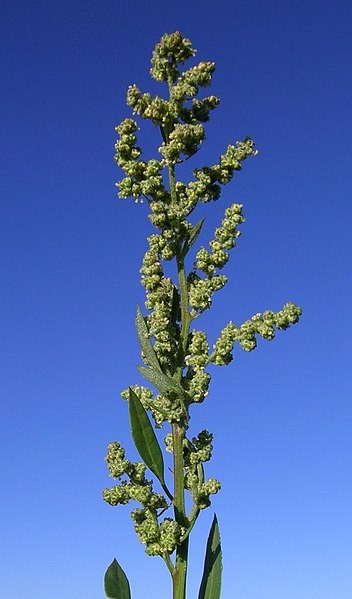Pitseed goosefoot
(Chenopodium berlandieri)

Description
Chenopodium berlandieri, also known by the common names pitseed goosefoot, lamb's quarters (or lambsquarters), and huauzontle (Nahuatl) is an annual herbaceous plant in the family Amaranthaceae. The species is widespread in North America, where its range extends from Canada south to Michoacán, Mexico. It is found in every U.S. state except Hawaii. The fast-growing, upright plant can reach heights of more than 3 m. It can be differentiated from most of the other members of its large genus by its honeycomb-pitted seeds, and further separated by its serrated, evenly lobed (more or less) lower leaves. Although widely regarded as a weed, this species was once one of several plants cultivated by Native Americans in prehistoric North America as part of the Eastern Agricultural Complex. C. berlandieri was a domesticated pseudocereal crop, similar to the closely related quinoa C. quinoa. It continues to be cultivated in Mexico as a pseudocereal, as a leaf vegetable, and for its broccoli-like flowering shoots. Chenopodium seeds vary in shape between lenticular and cylindrical.The lenticular shape is more typical of wild members of the species while cylindrical seeds (said to have a "truncated margin") predominate in domesticated varieties. The nutritive perisperm tissue is encircled by the embryo along the seed margin. The radicle protrudes slightly, producing a visible bump in the circumference of the seed (called the "beak"). Surrounding the perisperm and embryo are three layers: the inner epiderm, the outer epiderm, and the pericarp. The inner epiderm is also called a tegmen. The outer epiderm is synonymous with testa. Together, the outer and inner epiderm make up the seed coat. In Chenopodium literature, the terms outer epiderm, testa, and seed coat are often used interchangeably. The pericarp is often dehiscent, but is non-dehiscent in some varieties.In domesticated varieties, the seed coat may be reduced or absent. Uniform seed assemblages with seed coats less than 20 µm thick are considered to represent domesticated population. Conversely, wild populations tend to produce seeds with seed coat thicker than 20 µm.
Taxonomic tree:







